| PREP TIME | REST TIME | COOK TIME |
| 10 mins | 1 to 6 h | 15 mins |
This pan-seared strip steak has a deep, dark, and crispy crust on the outside and is perfectly cooked inside, with only a relatively thin gray band under the crust. Finished with garlic-herb butter, it’s incredibly rich, flavorful, and surprisingly simple to make at home.
Important
I developed this recipe for strip steaks that are about 1 1/2 to 2 inches (3.8 to 5.1 cm) thick. If your steak is thinner or thicker, you’ll get better results by following one of my other recipes:
- 0.5-inch (1.3 cm) Steak in a Pan
- Thin Strip Steak in a Pan (about 1 inch / 2.5 cm thick)
- 2.5-inch (6.3 cm) Steak in a Pan
If you’d rather use another cooking method (like sous vide, reverse sear, or anything else), check out my full list of strip steak recipes.

Making the perfect strip steak at home takes a little care, but it’s not as hard as you might think. In this recipe, I show you how to finish the steak with butter in the pan. With this technique (whether you flip the steak in the butter or baste it), you should expect a higher carryover increase. That’s why I recommend using a strip steak that’s at least 1½ inches (3.8 cm) thick. Thinner cuts cook so fast that there’s almost no room for even a small error.
If you skip the butter basting and use compound butter instead, or prepare the aromatics in the pan while the steak rests after searing, then this recipe works well for much thinner cuts, even those as thin as 1/2 inch (1.3 cm) thick.
To be clear, I’m not against butter basting. I’m against doing it with thinner steaks because, for most people who don’t cook steak often, this technique is too complicated and comes with a much higher risk of overcooking. You don’t need to butter-baste a steak to get an impressive crust or rich, buttery flavor. There are easier techniques that work just as well. The truth is, classic pan-searing is one of the most challenging ways to cook a steak due to the fast cooking time and the high carryover effect once the steak comes off the heat.
The Ingredients You’ll Need
- Strip steak: A 1½ to 2-inch (3.8 to 5.1 cm) thick strip steak (New York strip). If you’re skipping the butter basting and using compound butter instead, you can go with a cut about 1 inch (2.5 cm) thick.
- High-smoke-point oil: 1–2 tablespoons (15–30 ml). Use 1 tablespoon for a well-marbled cut, or 2 tablespoons for a leaner one. I recommend refined avocado oil for its neutral flavor and high smoke point (about 500°F / 260°C).
- Kosher salt: 1–2 teaspoons (5–10 g) per steak. A good rule is to use about 1% of the steak’s weight in salt, or up to 1.5% if you prefer a stronger, more seasoned flavor.
- Black pepper (optional): About ½ teaspoon of finely ground black pepper per pound (454 g) of steak.
- Butter (optional): 2 tablespoons (28 g) of unsalted butter. You can use a little more if you plan to butter-baste the steak.
- Garlic: 2–3 cloves. No need to peel them.
- Herbs: 2 sprigs of fresh thyme or rosemary.
- Compound butter (optional): If you want to keep the recipe simple but still get great flavor, skip the aromatics in the pan (butter basting) and place compound butter on top of the steak as it rests. I highly recommend this option if you’re not confident with pan-searing. Make a larger batch, use what you need, and store the rest in the refrigerator or freezer.
The Tools You’ll Need
- Pan: A cast-iron skillet (preferred), carbon steel pan, or heavy-bottomed stainless steel skillet.
- Tongs
- Meat thermometer: Use whichever type you like. An instant-read thermometer is perfect for quickly checking the steak’s internal temperature. A leave-in probe thermometer allows you to monitor the temperature from start to finish as the steak cooks.
Note
This recipe is for a thicker strip steak. Thicker steaks are easier to cook, so instead of buying two thin ones, opt for a thicker cut and share it if it feels too large to eat on your own. Or save the leftovers and use them the next day for something like tacos or a steak sandwich. See the list of leftover steak recipe ideas.
How to Pan Sear Strip Steak – Ultimate Guide
This recipe isn’t just a list of steps. It’s a detailed guide that explains what to do and why, so you can cook a great strip steak and get it right every time. Below is a detailed, step-by-step guide with explanations and photos on how to pan-sear a strip steak on the stove.

Step 1: Prepare the Strip Steak
Remove the strip steak from the fridge, pat it dry with paper towels, then decide on the next steps based on the desired results and available time:
- If you’re short on time: Leave the salted strip steak at room temperature for about 1 hour. That’s the bare minimum for dry-brining.
- If you have a few hours: Let it sit in the fridge for 4–6 hours. This is the best option if you want great flavor, a beautiful crust, and a minimal gray band under the crust. I highly recommend this option.
- For maximum flavor: You can dry-brine the steak for 12–24 hours, but expect a much thicker gray band under the crust (you won’t get that wall-to-wall pink doneness gradient inside). If the gray band isn’t an issue for you, go for it. The flavor and crust are phenomenal after a long dry brine.
Important: Regardless of the method you choose, remove the steak from the fridge 30 minutes before cooking and let it sit at room temperature. Letting the steak rest at room temperature before cooking helps it cook more evenly, so please, don’t skip this step. You can read more about this in my guide: Resting Steak Before Cooking.
Note
A dry steak surface is the key to a great crust, and moisture is the biggest enemy of a good sear. After you salt the steak, the salt pulls moisture to the surface, and over the next 40–60 minutes, the meat reabsorbs most of it. Here’s the main point: salt your strip steak at least 1 hour before cooking. This gives the salt time to improve the meat flavor and dries the surface enough to help you get a much better sear.
For even better results, place the steak uncovered on a rack in the fridge for 4–6 hours. This is the best option if you want a great sear while minimizing the gray band inside. Just keep in mind that the longer the steak sits salted, the larger the gray band forms under the crust (no matter how you cook the steak). From my testing, 4–6 hours in the fridge is the sweet spot; it significantly boosts flavor, dries the surface nicely, and minimizes the gray band. That said, if you don’t care about a really thick gray band and want even more flavor, leave the salted steak in the fridge overnight. I often do this when I want a deeper, saltier flavor.
Never sear a steak between 2 and 30 minutes after salting – its surface will still be wet, and that will ruin your sear.
For more details on timing and technique, see my article: How to Salt a Steak.
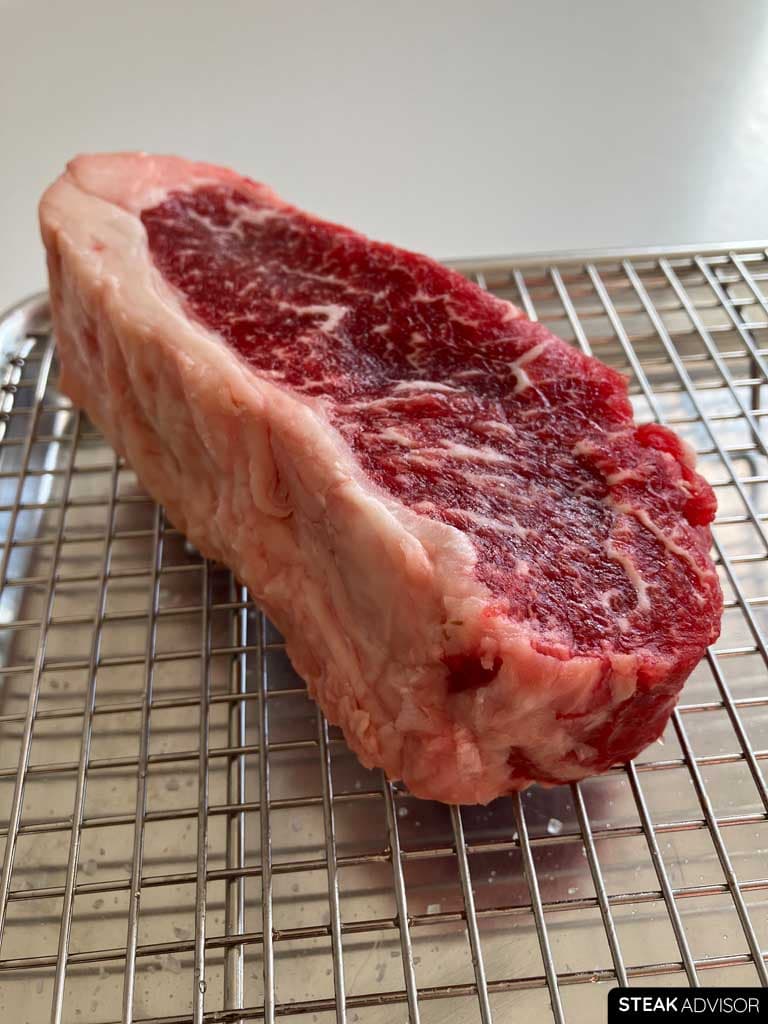
Step 2: Preheat the Pan
Place a heavy pan on medium-high heat, preferably a cast-iron skillet (or stainless steel or carbon steel). After about 3-4 minutes, add 1–2 tablespoons of high–smoke-point oil and let it heat for another minute. While the pan is heating, pat the strip steak dry again and season it with finely ground black pepper. Then move on to the next step.
Note
Always use an oil with a high smoke point for pan-searing. Your pan needs to reach at least 400°F (204°C) and ideally closer to 500°F (260°C), so you can’t use just any oil. You need a high–smoke-point oil. Refined avocado oil is one of my favorites and the one I use most often. It has a high smoke point and a neutral flavor. If you don’t have it, the table below lists other oils that work well for pan-searing.
| Type of Fat | Smoke Point ºF | Smoke Point ºC |
|---|---|---|
| Refined Avocado Oil | 520ºF | 270ºC |
| Refined Safflower Oil | 510ºF | 266ºC |
| Beef Tallow | 480ºF | 250ºC |
| Pecan Oil | 470ºF | 243ºC |
| Refined Peanut Oil | 450ºF | 232°C |
For the pan, choose one with a thick bottom that holds heat well and can handle high temperatures. A cast-iron skillet is my go-to for getting a really hard sear, but a good heavy-bottomed stainless steel or carbon steel pan works too. Avoid nonstick pans, as they aren’t designed for the high heat needed to cook a steak safely.
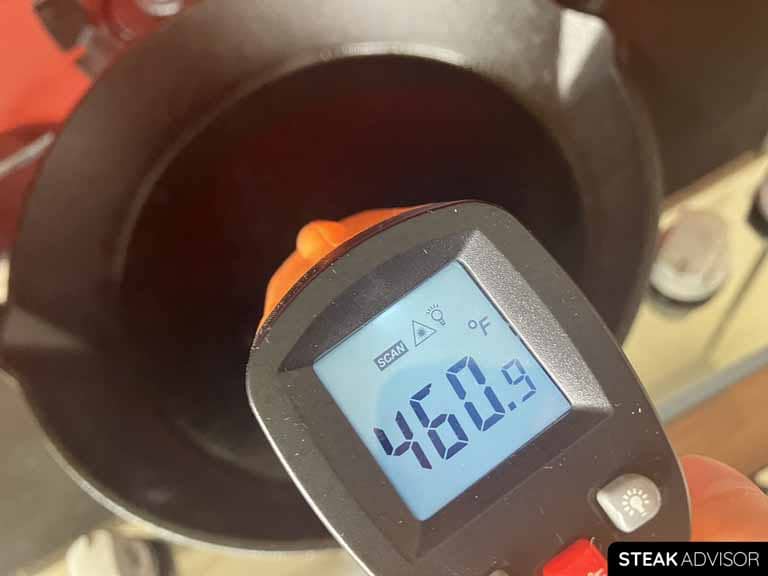
Step 3: Pan-Sear the Strip Steak
Start by placing the strip steak, fat side down, to render some of the fat. Let it sear for 30–60 seconds, and once the fat looks nicely rendered (browned and crispy), flip the steak to the meat side and start searing, flipping it every 30 seconds. Keep searing until the steak’s internal temperature reaches 90°F (32°C) if you plan to butter-baste it. Once it reaches that point, move to step 4, “butter basting”.
If you want to keep things super simple, you can skip the butter basting (Step 4). In that case, flip the steak every 30 seconds until the internal temperature is about 20°F (11°C) below your target doneness (see the temperature chart below). Then turn off the heat, remove the steak from the pan, and let it rest for 6-7 minutes. While it rests, you can finish it with compound butter or prepare the aromatics in the pan (see Step 6).
| Doneness | Remove at temp: | Final temp: |
| Rare | 100–110°F (38–43°C) | 120–130°F (49–54°C) |
| Medium Rare | 110–120°F (43–49°C) | 130–140°F (54–60°C) |
| Medium | 120–130°F (49–54°C) | 140-150˚F (60–66°C) |
| Medium-Well | 130–140°F (54–60°C) | 150-160˚F (66–71°C) |
| Well Done | 140–150°F (60–66°C) | 160°F+ (71°C+) |
Note
Cooking time varies based on several factors, including the thickness of your strip steak, how long it rests before cooking, and the equipment used, such as the stove, burner power, and type of pan. Please note that recipe times are just rough estimates, not exact guidelines. That’s why I always recommend getting a meat thermometer.
If you don’t own one yet, get an instant-read thermometer (they’re not expensive at all). A meat thermometer is the only reliable way to hit the doneness you want every time. It’s one of those tools that makes a huge difference when cooking steak.

Step 4: Butter Basting (optional)
Don’t start searing the steak with butter. Its smoke point is too low, and it will burn long before the steak is ready. Wait until the steak reaches about 90°F (32°C) if you’re aiming for medium-rare/medium, or around 100°F (38°C) if you want it medium/medium-well. Once it reaches that point, add the garlic, herbs, and butter to the pan, then lower the heat to medium-low. Let the butter melt, then tilt the pan and spoon the melted, aromatic butter over the steak.
Baste for about 30 seconds per side, checking the temperature as you go. Keep cooking until the steak is about 20°F (11°C) below your target doneness (see the chart above), then remove it from the pan and let it rest for 6–7 minutes.
Alternatively, tilt the pan to pool the butter, then place the steak directly in it and flip it every 30 seconds until it’s about 20°F (11°C) below your target doneness. Basting looks cool, but honestly, both methods give you almost the same result.
Note
Always lower the heat to low when you start basting so the butter doesn’t burn. You want it golden-brown, not black. Butter burns fast at high heat. Its smoke point is only about 300°F (149°C), and burnt butter will ruin the flavor of your strip steak.
For 1.5–2 inch (3.8-5 cm) steaks cooked only in the pan, the carryover increase is usually about 20°F (11°C) based on my experience. But with butter basting, the carryover can be slightly higher, sometimes even 25–30°F (14–17°C). Why? When you flip the steak every 30 seconds, one side gets a moment to cool slightly before touching the hot pan again. With butter basting, the hot butter prevents the surface from cooling, so the steak cooks faster overall and creates a larger temperature difference between the surface and the center. That higher temperature gradient leads to a bigger carryover.
That’s why it’s important to add the butter when the steak hits 90–100°F (32–38°C), depending on your target doneness, and keep the basting short (about 1-2 minutes in toal while flipping the steak every 30 seconds), or until the internal temperature is about 20–25°F (11–14°C) below your target. This is also why I’m against basting thin steaks or recommending it to beginners. But don’t worry, you can still get that rich garlic-butter-herb flavor by using compound butter or making the aromatics while the steak rests. You’ll get the same flavor with far less effort and a lot less stress.

Step 5: Aromatics or Compound Butter Finish (optional)
If you skipped the butter basting, here are two simple ways to finish the steak with aromatics:
- Option 1 (compound butter): Place a bit of compound butter on top of the steak right after you take it out of the pan. The butter will melt over the hot steak as it rests.
- Option 2 (if you don’t have compound butter): Use the same pan you seared the steak in. Lightly brown a few peeled garlic cloves over medium heat, then add a couple sprigs of rosemary or thyme, and 2 tablespoons (30 g) of unsalted butter, letting it melt. Turn off the heat and pour the mixture over the sliced steak.
Note
I usually make a batch of compound butter and use it like in option 1, but the second option works well too. Both methods are simple and make searing easier, especially with thinner steaks around 1 inch (2.5 cm) thick. If your steak is thin or you’re not confident with pan-searing yet, I’d skip the basting and go with one of these methods instead.
Classic hot-and-fast pan-searing with butter basting is the most difficult way to cook a steak, so if you don’t cook steak often, stick to the easier methods.
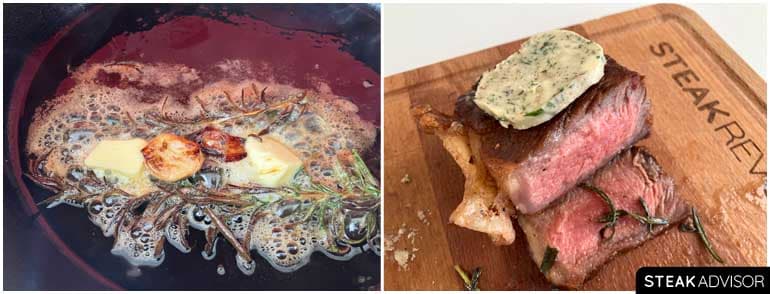
Step 6: Slice and Serve the Steak
After cooking, don’t forget to let the steak rest for about 5 minutes for cuts under 1.5 inches (3.8 cm) thick, and 6–7 minutes for steaks between 1.5 and 2 inches (3.8 to 5.1 cm) thick.
Once it’s rested, pour any leftover pan butter over the steak along with the garlic and rosemary (if you used them). If you used compound butter instead, you can go straight to slicing. For well-marbled strip steak, slice it however you like. For leaner cuts, slice against the grain. Then serve with your favorite sides.
Note
As the steak rests after cooking, its temperature can rise by 15°F to even 30°F (8°C to 17°C) due to the carryover cooking. If you slice into it right after cooking, you’ll stop that carryover. So please do not touch it while it rests unless your thermometer shows it’s already at the doneness you want and you want to prevent it from cooking any further. Keep in mind that this kind of high carryover increase happens with fast, extremely hot cooking methods like pan-searing or grilling over direct heat.
For more details, check out my guide: Resting Steak After Cooking: Why You Should and for How Long.
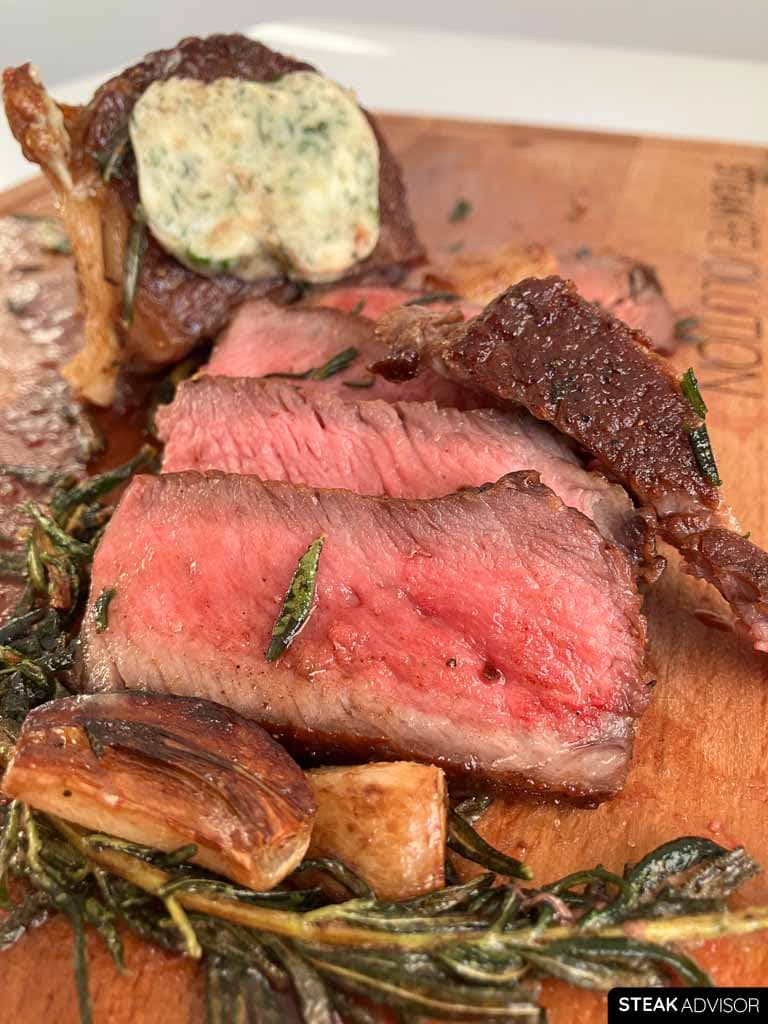
FAQs
How long does it take to sear a strip steak on the stove?
With this recipe, searing a 1¾-inch (4.45 cm) thick strip steak usually takes me about 6–8 minutes to reach 130–135°F (54–57°C). But don’t rely too much on the time. Cooking time changes based on the steak’s thickness, how long it rests, and the stove, burner, or pan you’re using. So think of that 6–8 minutes as a rough estimate, not a strict rule.
I strongly recommend using an instant-read thermometer to check the steak’s temperature. A wireless one is even better. It’s the most reliable way to make sure your strip steak turns out exactly how you want it.
When do I remove the strip steak from the pan?
A strip steak doesn’t stop cooking the moment you remove it from the pan. Food continues to cook as heat moves from the outside toward the center. The food surface gets much hotter than the inside, so once the steak comes off the heat, that stored heat keeps cooking it until the temperature evens out. This is what we call carryover cooking.
Because pan-searing uses extremely high heat, the temperature difference between the steak’s surface and center is much larger. As a result, you can expect the steak’s internal temperature to rise by about 15–30°F (8–17°C) as it rests. Thicker steaks and those that have been cooking longer usually have a higher carryover increase because their surfaces get even hotter.
From my own testing:
- For a strip steak 1–1½ inches (2.5–3.8 cm) thick, expect about a 20°F (11°C) rise.
- For a strip steak 2 inches (5 cm) thick, the rise can reach even about 30°F (17°C).
That’s why you must remove the steak from the pan before it reaches your target temperature. Here’s a simple chart showing when to take it off the heat to hit the doneness you want:
| Doneness | Remove at temp: | Final temp: |
| Rare | 100–110°F (38–43°C) | 120–130°F (49–54°C) |
| Medium Rare | 110–120°F (43–49°C) | 130–140°F (54–60°C) |
| Medium | 120–130°F (49–54°C) | 140-150˚F (60–66°C) |
| Medium-Well | 130–140°F (54–60°C) | 150-160˚F (66–71°C) |
| Well Done | 140–150°F (60–66°C) | 160°F+ (71°C+) |
What is the best doneness for strip steak?
Medium-rare is, in my opinion, the best doneness for strip steak. Here’s why: strip steak has a good amount of intramuscular fat (marbling). When the steak is undercooked, that fat stays firm and waxy. It starts to melt at about 130°F (54°C), so cooking the steak to medium-rare, ideally about 135°F (57°C), lets that fat render nicely. At this doneness, the steak stays tender, juicy, and incredibly flavorful. Medium-rare is my go-to because it brings out the best texture and taste.
Avoid going too rare, since the fat won’t have enough time to melt. On the other hand, cooking it past medium will start drying the steak out, making it noticeably less tender and less flavorful.
Print
Pan-Seared Strip Steak Recipe
- Prep Time: 10 mins
- Rest Time: 1 to 6 hours
- Cook Time: 15 mins
- Total Time: 1 hour 25 minutes
- Yield: 1 steak
Description
This pan-seared strip steak has a deep, dark, and crispy crust on the outside and is perfectly cooked inside, with only a relatively thin gray band under the crust. Finished with garlic-herb butter, it’s incredibly rich, flavorful, and surprisingly simple to make at home.
Ingredients
For Steak:
- 1½ to 2-inch (3.8 to 5.1 cm) thick new york strip steak (if you’re skipping the butter basting and using compound butter instead, you can go with a cut about 1 inch/2.5 cm thick)
- 1–2 tablespoons (15–30 ml) high-smoke-point oil (I recommend refined avocado oil)
- 1–2 teaspoons (5–10 g) kosher salt per steak (1-1.5% of the steak’s weight in salt)
- ½ teaspoon of finely ground black pepper per pound (454 g) of steak (optional)
- 2 tablespoons (30 g) unsalted butter (optional)
- 2–3 garlic cloves (optional)
- 2 sprigs of fresh thyme or rosemary (optional)
- Compound butter (optional)
Tools:
- Pan (cast-iron, carbon steel or heavy-bottomed stainless steel skillet)
- Tongs
- Meat thermometer (instant-read or probe thermometer)
Instructions
- Before we start, decide which aromatics you want to use and how you want to finish the steak. To keep things simple and reduce the risk of overcooking, skip the butter basting and place a slice of compound butter on top of the steak as soon as you take it out of the pan. Alternatively, prepare the aromatics in the pan while the steak rests after searing.
- After that, gather your ingredients and tools, then follow the steps below.
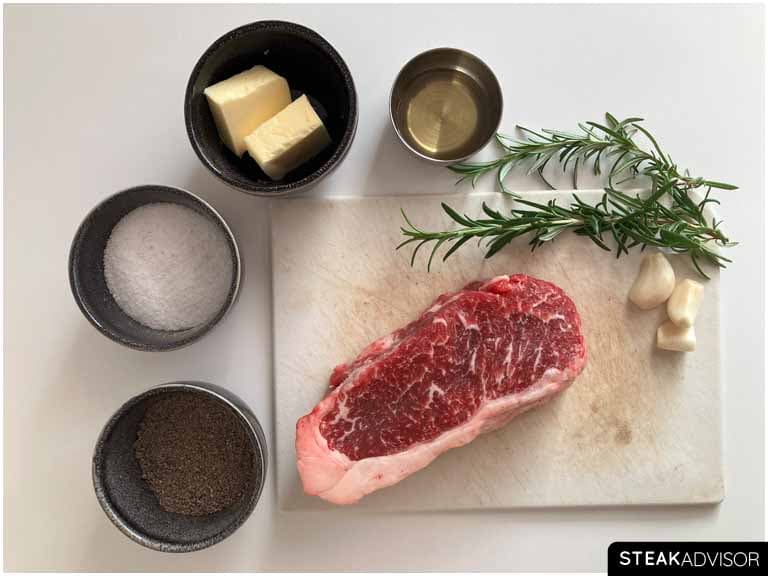
Prepare the Strip Steak
- Remove the strip steak from the fridge, pat it dry with paper towels, then decide on the next steps based on the desired results and available time:
- If you’re short on time: Leave the salted strip steak at room temperature for about 1 hour. That’s the bare minimum for dry-brining.
- If you have a few hours: Let it sit in the fridge for 4–6 hours. This is the best option if you want great flavor, a beautiful crust, and a minimal gray band under the crust. I highly recommend this option.
- For maximum flavor: You can dry-brine the steak for 12–24 hours, but expect a much thicker gray band under the crust (you won’t get that wall-to-wall pink doneness gradient inside). If the gray band isn’t an issue for you, go for it. The flavor and crust are phenomenal after a long dry brine.

Preheat the Pan
- Regardless of the salting method you choose, remove the steak from the fridge 30 minutes before cooking and let it sit at room temperature.
- Place a heavy pan on medium-high heat, preferably a cast-iron skillet (or stainless steel or carbon steel). After about 3-4 minutes, add 1–2 tablespoons of high–smoke-point oil and let it heat for another minute.
- While the pan is heating, pat the strip steak dry again and season it with finely ground black pepper (optional). Then move on to the next step.

Pan-Sear the Strip Steak
- Start by placing the strip steak, fat side down, to render some of the fat. Let it sear for 30–60 seconds, and once the fat looks nicely rendered (browned and crispy), flip the steak to the meat side and start searing, flipping it every 30 seconds.
- Keep searing until the steak’s internal temperature reaches 90°F (32°C) if you plan to butter-baste it. Once it reaches that point, move to section “butter basting”.

Butter Basting (optional)
- Don’t start searing the steak with butter. Its smoke point is too low, and it will burn long before the steak is ready. Wait until the steak reaches about 90°F (32°C) if you’re aiming for medium-rare/medium, or 100°F (38°C) if you want it medium/medium-well.
- Once it reaches that point, add the garlic, herbs, and butter to the pan, then lower the heat to medium-low. Let the butter melt, then tilt the pan and spoon the melted, aromatic butter over the steak.
- Baste for about 30 seconds per side, checking the temperature as you go. Keep cooking until the steak is about 20°F (11°C) below your target doneness (see the temperature chart below), then remove it from the pan and let it rest for 6–7 minutes.
- Alternatively, tilt the pan to pool the butter, then place the steak directly in it and flip it every 30 seconds until it’s about 20°F (11°C) below your target doneness. Basting looks cool, but honestly, both methods give you almost the same result.
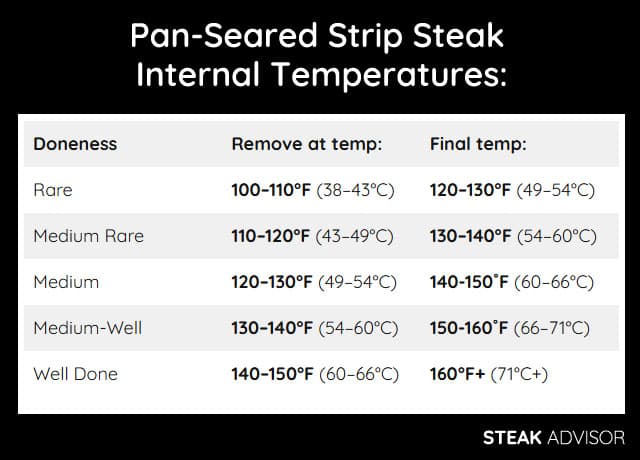
Simpler No-Baste Option
- If you want to keep things super simple, you can skip the butter basting. In that case, flip the steak every 30 seconds until the internal temperature is about 20°F (11°C) below your target doneness (see the temperature chart above). Then turn off the heat, remove the steak from the pan, and let it rest for 6-7 minutes.
- While it rests, you can finish it with compound butter or prepare the aromatics in the pan (see instructions in the next section).
Aromatics or Compound Butter Finish (optional)
- If you skipped the butter basting, here are two simple ways to finish the steak with aromatics:
- Option 1 (compound butter): Place a bit of compound butter on top of the steak right after you take it out of the pan.
- Option 2 (if you don’t have compound butter): Use the same pan you seared the steak in. Lightly brown a few peeled garlic cloves over medium heat, then add a couple sprigs of rosemary or thyme, and 2 tablespoons (30 g) of unsalted butter, letting it melt. Turn off the heat and pour the mixture over the sliced steak.

Slice and Serve the Steak
- After cooking, don’t forget to let the steak rest for about 5 minutes for cuts under 1.5 inches (3.8 cm) thick, and 6–7 minutes for steaks between 1.5 and 2 inches (3.8 to 5.1 cm) thick.
- Once it’s rested, pour any leftover pan butter over the steak along with the garlic and rosemary (if you used them). If you used compound butter instead, you can go straight to slicing. For well-marbled strip steak, slice it however you like. For leaner cuts, slice against the grain (see notes below). Then serve with your favorite sides.

Notes
Slice against the grain
If you’re working with a lean strip steak, it’s a good idea to slice it against the grain. This shortens the muscle fibers, making each bite easier to chew. It’s one of the simplest and most effective ways to turn a slightly tough, chewy cut into something noticeably more tender, since your teeth don’t have to work as hard to break through the muscle fibers. If you’re not sure how to find the grain direction, check out my steak slicing guide.

